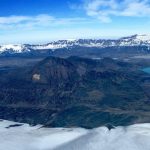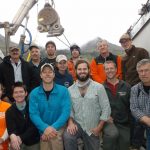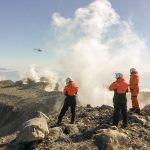Field work in the Aleutian Islands is complex, expensive, and thoroughly exciting. When the community suggested to NSF that we facilitate a collaborative field platform to get safely to and from the many islands of interest along the arc, we turned to our colleagues in the Division of Polar Programs (PLR). They helped us coordinate, along with the USGS and Alaska Volcano Observatory (AVO), a combined logistics platform of ship and helicopters that could support the science proposed by our eager PIs.
Planning began in the summer of 2014, as we looked at the proposals that had come into the GeoPRISMS deadline focused on work in Alaska and the Aleutians. What was funded from that round was a group of well-reviewed proposals that together we felt had a chance to make real progress on the goals laid out in the Science and Implementation Plan. We got to work with the PIs, the USGS & AVO, Polar Field Services (who would manage the logistics), and PLR to set up the work, get everyone permitted, and get our scientists in the field. We leveraged funds from a number of places to make this work. EAR and OCE, via the GeoPRISMS Program, funded the bulk of the platform. The Directorate for Geosciences (GEO) contributed funds as well. The GeoPRISMS project shared mobilization costs with a previously-funded Arctic Social Sciences project. The Polar Geospatial Center generated DEMs and maps to help researchers better target their time on these remote islands.
In the summer of 2015, three teams of academic researchers along with scientists from the USGS & AVO set off on unprecedented coordinated research in the Aleutian Islands. They shared ship and helicopter time aboard the Maritime Maid, a helicopter-capable research vessel that traveled along more than 800 miles of volcanic arc, from Dutch Harbor in the east to Buldir Island in the west, transporting scientists and equipment on and off the islands. The USGS, already involved in assisting our scientists with permitting and field expertise, also funded their own helicopter time to service monitoring stations on volcanoes, some of which hadn’t been visited in many years. The Deep Carbon Observatory, funded by the Sloan Foundation, provided additional support for a fourth team of researchers to occupy the remaining free berths on the Maritime Maid, maximizing the efficiency of the ship and the potential for real scientific progress.
Field work included rock and gas sampling from numerous volcanoes, as well as geophysical deployments (seismic and magnetotelluric) via this joint logistics platform and parallel-funded projects in the eastern part of the arc. The scientists involved were interested in a range of topics, including magma storage beneath the volcanoes, the chemistry and style of eruptions, and earthquake and tsunami hazards in the Pacific.
This multidisciplinary, multi-scale, collaborative work has already and will, in the future, yield remarkable results that help forward the goals laid out in the GeoPRISMS Science and Implementation Plan. The researchers returned home (mostly) unscathed and very scientifically successful, and both NSF and the USGS have praised the endeavor which uniquely coordinated resources to accomplish the goals of two federal agencies. The GeoPRISMS Program estimates that we saved nearly a million dollars by leveraging what we could, partnering with experts, and being strategic in our thinking, funding, and planning.
– Maurice Tivey
GeoPRISMS Program Manager, National Science Foundation





